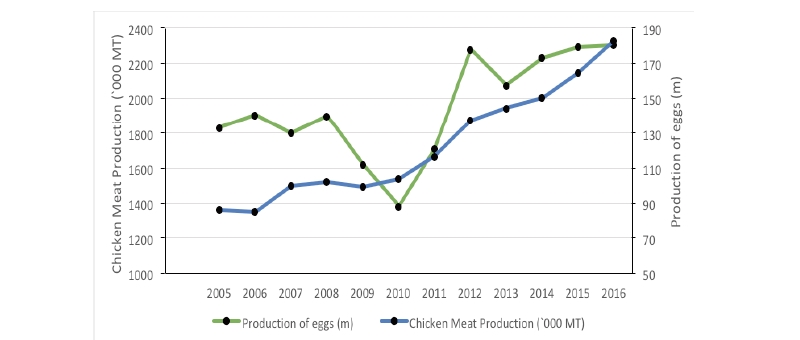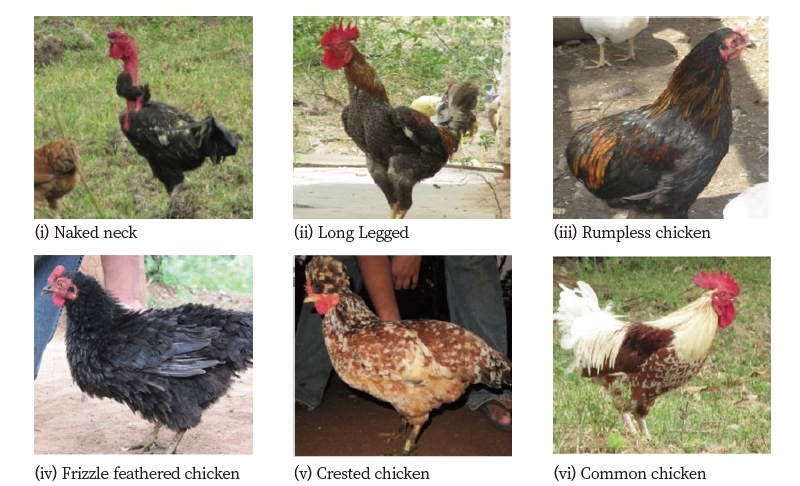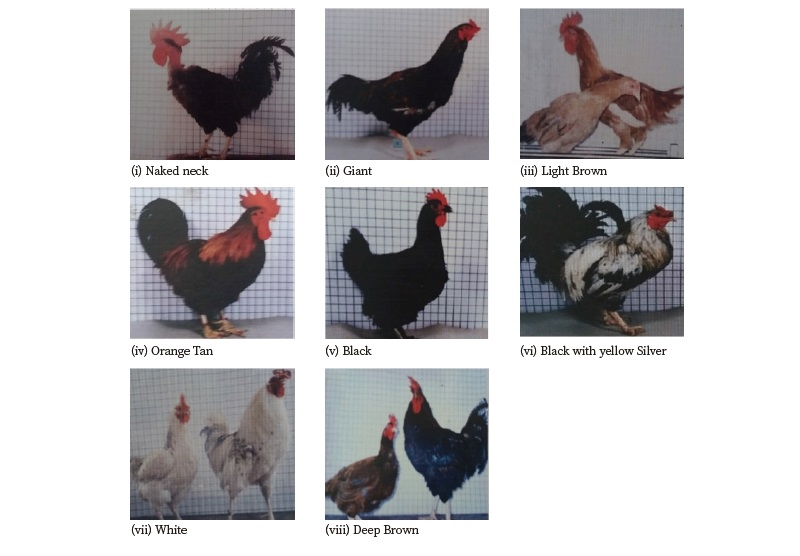Introduction
Poultry sector in Sri Lanka has recently placed in a higher position due to higher contribution to National GDP. It developed as countries most disciplined and well organized livestock subsector which generates the billions of tax revenue compare to the other livestock and fisheries (Economynext, 2017).
The two main poultry rearing systems namely indigenous (back yard) chicken rearing and commercial farming system are noted. Indigenous poultry production system contributes approximately 15% to the egg production and very low to the meat production. Whereas, 85-100 % meat and table egg production is covered by commercial farming system (Atapattu et al., 2016). It has noticed that combination of the two system of production has the ability to alleviate poverty through creating direct and indirect income source to the rural and urban households.
Most importantly, Sri Lanka holding a rich genetic pool of chicken. One of the wild ancestors known as Gallus Lafayettii (Ceylon jungle fowl) and locally adopted breeds are reported. However, low population size indicates the stagnation in the distribution and less attention to the local breeds. However, backyard poultry production system still play an important role in socio-economic fabric of rural Sri Lanka. There is a significant role from private sector to uplift the commercial poultry sector for producing the broiler meat and table eggs with genetical advancements (CIC, 2017). Genetically improved high producing breeds recently introduced to the country and maintained under the high tech, controlled environment facility. Over the past few decades, population growth and increasing per capita income and urbanization has influenced the production of poultry meat and egg in the country (Sugiyama et al., 2003). To cater the demand at present, the industry is mainly controlled by the private sector, while the role of the state being limited mostly for implementation of poultry health management program, research and policy development for further consolidation of the industry. Therefore, in this review, we addressing the past development and present status of the poultry sector while providing the general idea of production system and genetic resources.
Sri Lankan poultry industry - past and present status
Chicken is the dominant avian species that contribute to the large portion of daily meat demand in most Sri Lankan diets. Thereby, chicken as a main poultry species has significant growth in farming and largely distributed across the country. The poultry sector is well-established compare to the other livestock industries in the country. Both traditional village chicken, exotic breeds and adopted strains (broiler/layer) play key roles in the system. However, after the 1955, significant development in industry is observed with 100 % private contribution to develop the commercial poultry farms where the indigenous poultry production is still stand behind for their contribution due to minimum consideration and poor management strategies. Therefore, back-yard poultry is mainly for egg production and fulfill the family meat requirement (Wickramaratne, 1999; Gamage et al., 2005). Thus, identified as an effective means for reducing the poverty of rural community.
Evolution of Sri Lankan poultry industry can be summarized by few main events, which cover the comprehensive picture of the industry. Since colonial times, back-yard system has been an integral part of the crop-livestock integrated farming system in the all part of Sri Lanka. Apart from the economical perspective, chicken is bound with cultural and religious events of people in the country. However, this traditional system has changed to organized farming system back in the day 1950s. The “Central poultry research station (CPRS) Karadagolla”, was established in 1954 with purpose of develop the industry by providing the quality genetic material for production, technical extension services, research and development.
In 1955, government initiated a program to upgrade the industry. As a result, male birds of improved strains were distributed among the local households to increase of egg production by crossbreeding with indigenous chicken. Simultaneously, deep litter system was introduced. Subsequently, in 1960s parent birds were imported. In 1970, initiation of poultry industry took place with involvement of both government and private sector. Rapid progress in industry especially exponential growth was more prominent in broiler sector. Reasonably this change may be due to rapid adaptability of advancements in technology and high rate of reproduction, a quick return on capital invested and less land requirement (Sugiyama et al., 2003; Iddamalgoda et al.,1998). Recently a higher expansion is observed in the layer sector, despite the initial lag growth (DAPH reports, 2017).
The poultry population has almost doubled in 2017 (21.28 million) compared to year 2005 (11.63 million ). Until 2012, the population remained stable (12-14 million) and then increased sharply with a 9.2% average annual growth rate. However, there was a slight decline in 2009 and 2010 due to the prevailed birds-flu (Highly pathogenic avian influenza) condition and unfavorable economic condition due to global financial crisis (Chantong and Kaneene, 2011; Te Velde, 2008). By 2013, the population reached more than 16 million owing to recent government development projects such as “Divi Naguma” program. Livestock statistical bulletin of the department of Animal Production and health (2016) of Sri Lanka stated that, in 2015 the poultry population comprised of 12.1 million broiler chicken and 18.81 million layers along with a small fraction of backyard poultry (1.7 million). In addition, broiler grandparents, broiler parents and layer parents contributed to the population by 0.09, 2.82 and 1.68 million, respectively.
At present, approximately 80% of chicken production is concentrated mainly in six districts in the country, namely Kurunagala, Puttalama, Gampaha, Colombo, Kandy and Kaluthara. Kurunagala district having the highest chicken population accounted for 43.5% of the total production. Furthermore, poultry population in Kurunagala district has increased by approximately 10% during the last ten years. In 2016, the lowest chicken population reported in Matara (0.49%) and Hambanthota (0.57%) covering the Southern province and Mullativu (0.51%), Manna (0.53%), Kilinochchi (0.7%) and Vavuniya (0.71%) districts of Northern Province.
During the last decade, there was a steady growth in chicken meat production. In 2008 and 2009, the growth has stagnated, subsequently there was a drastic climb up toward the end of the period. In contrast,the egg production has highly fluctuated throughout the last 10 years. The threat of bird flu outbreak has made severe impact on the egg industry. Consequently, the egg production had dropped down by 515.49 million in 2010 compared to the 2008. Nevertheless, it significantly elevated during recent years. The current per capita availability of chicken meat and eggs estimated to be 8.56 kg and 108.43 eggs, respectively (DAPH Key statistics, 2016). According to the current purchasing levels of the consumers, the Sri Lankan poultry industry is capable of producing all local requirements of chicken meat and eggs. Each year the demand for both chicken meat and eggs show a distinct price hike during the festival seasons, especially in April (traditional New Year festival time) and December (Christmas and New Year festival time). (Gajaweera, 2015; Wickramarachchi et al., 2017; Iddamalgoda, 1998; Bogahawatta, 1987).
Chicken farming systems
Alike most of the developing countries, Sri Lanka also implement two main poultry rearing systems. Such as indigenous chicken production systems (back-yard system) and commercial production system. Both rearing systems have divided in to several operation systems based on the farming input and output factors. The commercial poultry rearing system is consisted with 1) Intensive large scale operation (where Exotic broiler and layer strains are reared) 2) Semi– intensive medium scale operation 3) Buyback (contract) rearing system whereas, in indigenous chicken (IC) production is mainly implement under the 1) back yard system or small scale scavenging village chicken system and 2) semi-intensive system. (Chandrasiri, 2002; Silva el at.,2016)
Generally, indigenous poultry is characterized as a low input–output based system, which mentioned above (Silva et al., 2016; Bulumulla, 2013; Sanjeewa et al., 2011). The Average flock size is range between 10-60 birds, which is higher among the south Asian local chicken rearing system. In addition, the tropical livestock unit (TLU) in Sri Lanka is 0.31+0.09 (Bett et al., 2014). Farmers can maintain this system with a minimal land area integrated with crop cultivation (rice, coconut, and small crops) and other livestock species like dairy cattle, goat by considering the characteristics of the IC rearing system. Under the backyard operation, this system is not required to provide the permanent shelter during the day and (or) night. Feeding is totally depends on the scavengeable feed resources such as kitchen waste, grains, and any edible materials available in the garden. However, in semi-intensive system, farmers mostly target the local poultry production for their income generation. Therefore, improved management practices were observed. As a result improved egg production (100-200 eggs per year/bird) can be notice (Gunaratne et al., 1993; Sanjeewa et al., 2011).
Transformation in poultry industry from free-range system to small-scale intensive system, then intensive system was observed during the last few decades. The system, facilitate large number of birds for breeding and production. High quality breeding material, technology, veterinary care, lab service, optimized feeding, bio security measures, and controlled environment condition are established and implemented to improve the production of day-old chicks (DOC), quality meat and eggs. Generally, this system is consisted with three tiered such as grandparents, parents and commercial production. The producer driven commercial broiler system particularly can be divide into two-market component, namely live-weight market and large-scale live broiler to processed chicken meat integration system.
In contract farming system, where all intermediate smallholder farmers work as producers, so they receive the DOC from contracted mother farms and other facilities were supplied to the farmers and then the output (live birds) return to the processer of main venture or to the wet-market
Genetic resources, Characteristics and Distribution
Wild Ancestor
Gallus lafayettii (previous G. Stanleyi) commonly known as Ceylon jungle fowl (Figure 4) inhabits only in Sri Lanka. Even though, they show some morphological resemblance to red jungle fowl (Gallus gallus) their unique plumage color, comb and shank color separate them from other species. It has reported that they are closely related to the grey jungle fowl (Wong at al., 2004). They are spreads throughout the country specially, forests and scrub habitats in dry zone, forest and tea lands in wet zone and central highlands. Wild jungle fowls is described as facultative polyandry and they lay 2-4 eggs with various color combination, such as cream with a yellow or pink tint. Purple or brownish spots are common. There is no evidence to prove the introgression of wild in to domestic breeds or vice versa (Silva et al., 2016).
Local ecotypes
There are no defined breeds identified in the local industry. However, a comprehensive study conducted on village chicken under the multi-country GEF-UNEPILRI-FAnGR Asia project (Liyanage et al., 2015) has made an effort to classify the village chicken population into local ecotypes based on their distinct appearance and farmers perception on performance and behavior of the birds (Silva et al., 2016). In this study, they reported several ecotypes based on the comb types (single, rose, cushion, strawberry), different feather colors and feather patterns (mottled, Laced, barred) and finally, based on different shank color (yellow, black, pink, grey, and greenish).
In general, five local chicken types have identified namely; Naked neck, Long Legged, Frizzle feathered, Crested/crown and an admixture of all, which was classified as common chicken (Figure 5) (Silva et al., 2010). Samaraweera et al (2014) reported that local chickens have considerably high genetic diversity based on microsatellite markers, however low genetic differentiation between populations. One of reasons may be “clonal reproduction” mode existed in the back yard system make constant gene flow through sharing several breeding cock(s) among the villages (Samaraweera et al., 2014: Silva et al., 2014). All local types reared for the dual purpose. Their individual qualitative characteristics and performance, meat quality and egg quality parameters under the main production systems are described elsewhere (Silva et al., 2016; Rajapaksha , 2014; Sanjeewa et al., 2011; Niroshan et al., 2004; Wickramaratne et al., 1993).
Evidence for locally developed and improved strains
During 1940s, improved males of Rhode Island Red, White Leghorn, Light Sussex, Australorp, Cornish, Plymouth Rock were introduced and cross breed with indigenous types (Gamage and Gunaratne, 2009). The first generation of this developed line was brought less success within the back-yard system due to poor breeding and brooding capacity. Later, intervention of CPRS breeding activity to improve the strain that can utilize the local feed resources. Gamage et al (2005) and others conducted a series of breeding projects to evaluate the local ecotypes on-station. The collection of ecotypes consisted with, Naked neck, Giant, Deep brown, Orange brown, Orange Tan, Black, Black with yellow silver, White and Light Brown (Figure 6). The results suggested, these ecotypes have considerably high genetic diversity and higher heritability for body weight. Therefore, those could be select for body weight to develop strains that could thrive under the scavenging system.
In spite of local ecotypes, CPRS has introduced an improved strain of chicken. The breeding programs were focused on specific attributes and specific goals match to production system. Such one goal is to develop breeds for improved feed efficiency. Initially they have created two-way white egg strain 250H3 a cross breed of two White Leghorn lines (A & B). This strain was popular among the commercial egg producers despite their production capacity was far low than imported strain at that time. In addition, a two-way tinted egg strain known as “Rho white”, a cross of Rhode Island Red cockerel to a White Leghorn hen. This strain was gain much attention during the time of introducing the deep litter system. (Gamage and Gunarathne, 2009)
In the early 1980s, requirement of new strain that can have higher production, which can improve the status of smallholder poultry sector, was identified. In 1988, three-way terminal crosses were developed to create new pure lines. Furthermore, they have separately developed these for white and brown egg layers known as “CPRS White and brown egg layers” that have an ability to produce 15 eggs per month. Initially, they have developed ten unrelated white egg and 12 unrelated brown egg layer lines. Subsequently, three final strains were selected through a series of partial and complete diallelic test. The lines further crossed as mentioned elsewhere (Figure 7) to obtain terminal three way crosses. Both strains were tested on both on-farm station and off-farm station and deduced improved production similar to imported strains (Gamage et al.,1997; Jeyaruban et al., 1996).
Commercial strains
In early 1970’s, Sri Lanka has imported some commercial strains for development of the industry. A Hybrid of Cornish and Plymouth Rock for broiler production has introduced by department of agriculture under the open economic policy. However, today most of high producing breed were taken over the commercial layer and broiler industry, is totally depend on the imported Grandparent (GP) and parent (P) stocks for breeding. Broiler strains such as cobb-500, Arbor acres, Hy-line, Indian-River, and layer strains; shaver, Indian River, Hy-lines are commonly use. All the commercial strains distributed throughout the country, especially in poultry belt (Kurenegala, Puttlan and Kaluthara) and some part of the up-country.
Few private companies hold the sole power of commercial broiler and layer breeding in Sri Lanka. Currently, there are three grandparents breeding farm producing the large-scale parent’s birds of Hubbard Classic, Cobb 500 and Indian River Strain to 33-parent farm where they produce day old broiler chicks for country use and for import to some extent. More than 91% of parent bird requirement is fulfilled by these three main GP farms. On the other hand, eleven-layer breed farm produce the countries’ layer DOC requirement (DAPH reports, 2017). Nevertheless, few poultry breeding farms currently operate under National Livestock Development Board (NLDB) supply small contribution to the state DOC production, numerically >2% of broiler and >5% of layer (Gamage and Gunarathne, 2009).
Future Concerns
It is clear that the Sri Lanka has rich genetic resources and well establish commercial scale industry. In fact, there are lack of proper guidelines and policy framework for development and conservation of local genetic resources is the main concern.
Particularly, the population of commercial poultry also expanding daily and the chances of crossing local birds with the commercial breeds also happening in some areas. That would have advantage as well as disadvantage. Because when mixed with higher producing layers that would improve the production characteristics but it may cause to dissipated the inherited phenotypic characters of local types with time. On the other hand, lack of expertise and poor financial involvement to protect and upgrading local poultry by either privet or government sector affecting badly on development of the local breeds. Moreover, existing legal framework of the country regarding the local genetic resources has positive as well as negative consequences. Such as, even collecting a sample for study purpose from wild chicken is very difficult.
In further concern, prevention and controlling any disease outbreak, such as highly pathogenic diseases like Avian Influenza would be a threat in future. This may be due to, most of small and medium scales poultry farms are not registered. Also due to the improper management, such as lack of vaccinations against vital poultry diseases. Thus, if any outbreak starting one part of the country that can easily spread throughout the country. Then majority of poultry population could be destroyed easily with in short time.









